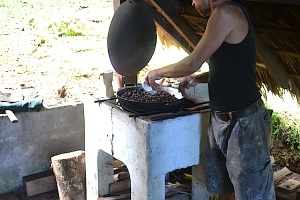Chocolate!
 What delicious chocolate they make here at a small organic cocoa farm, called Chocorart, a short bike-ride from our place! Yesterday morning Chico and I had a tour of the farm, and saw the chocolate-making process, then got to sample some of the amazingly good chocolate in a few forms at the end of the tour. Here’s what we learned:
What delicious chocolate they make here at a small organic cocoa farm, called Chocorart, a short bike-ride from our place! Yesterday morning Chico and I had a tour of the farm, and saw the chocolate-making process, then got to sample some of the amazingly good chocolate in a few forms at the end of the tour. Here’s what we learned:
Cocoa trees live only in consistently warm and humid locations, and like to grow in partial shade. A single tree will produce between 60 and 90 fruits each year, and the fruits look kind of like winter squash, coming in a few different colors (yellow, orange, and red). Each fruit has a hard outer coating which once cracked with a machete or vigorous thumping reveals 20-50 almond-sized seeds, the actual cocoa beans, surrounded by sweet and slimy white pulp.  The pulp is used to make a refreshing local drink, and we were told was fermented to make beer in ancient Brazil (an idea I’ll email to the Dogfish Head brewery guys: beer and chocolate—what could be better?!). [Update: looks like they already did it. Will have to get some of that! Dogfish Theobroma ]
The pulp is used to make a refreshing local drink, and we were told was fermented to make beer in ancient Brazil (an idea I’ll email to the Dogfish Head brewery guys: beer and chocolate—what could be better?!). [Update: looks like they already did it. Will have to get some of that! Dogfish Theobroma ]
The trees produce fruits all year, but there is a big harvest between September and December. The fruits are hand-picked, then cracked and the cocoa beans put in large wooden bins to ferment. This is a crucial and smelly part of the chocolate-making process, which lasts no more than seven days. At that point the fermented beans are put in a single layer on the drying trays in the sun. Drying takes between a week and a month depending on the weather. 
Once the beans are dry they taste good! We tasted some shelled beans at the end of the drying process, and the flavor was mild and nutty.
Next the beans are roasted in an open pan over a fire for an hour or so,  and spread on a cloth on the floor, where the protective outer husks are removed by rolling a heavy stone over the top of the roasted beans.
and spread on a cloth on the floor, where the protective outer husks are removed by rolling a heavy stone over the top of the roasted beans.  The resulting mix of beans and husks is sorted by slowly pouring the mixture in front of an electric fan, which blows the lighter waste away, leaving the essential nibs.
The resulting mix of beans and husks is sorted by slowly pouring the mixture in front of an electric fan, which blows the lighter waste away, leaving the essential nibs. 
Finally the nibs are ground in a small, hand-cranked machine that looks like a peanut-butter grinder in a health food store. And out comes oily cocoa butter paste, which can be turned into all kinds of delights. At Chocorart they produce chocolate in three forms: the shelled roasted beans, small blocks of hard pure ground cocoa, and cigars of flavored, sweetened dark chocolate. At the end of the tour we got to taste hot cocoa, which was like the chocolate equivalent of espresso; hot fudge over banana slices; and pieces of vanilla-flavored dark chocolate bar.  The combination of theobromines (“food of the gods” chemicals related to caffeine and found in high concentration in dark chocolate), the super-rich flavor, and the lovely day had us truly euphoric as we left what was a highlight of our trip so far.
The combination of theobromines (“food of the gods” chemicals related to caffeine and found in high concentration in dark chocolate), the super-rich flavor, and the lovely day had us truly euphoric as we left what was a highlight of our trip so far.


OH GOSH SO JEALOUS.
we’ve been learning all about cacao and the role it played in the Aztec social hierarchy. since cacao beans were the local currency in Mesoamerica (until like, the 1500s), you knew you were well-off when you could drink hot chocolate after dinner. it’s like a milkshake made with 20 dollar bills. HOW COOL IS THAT.